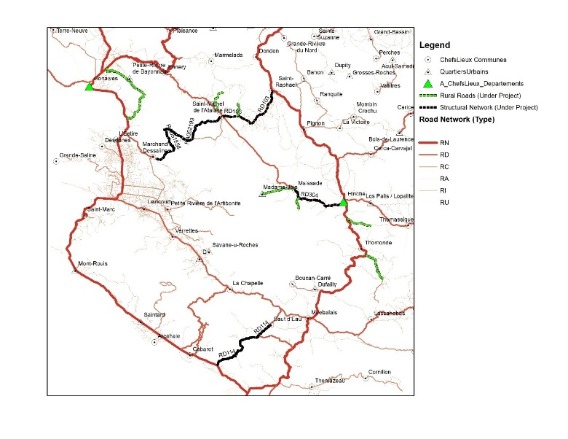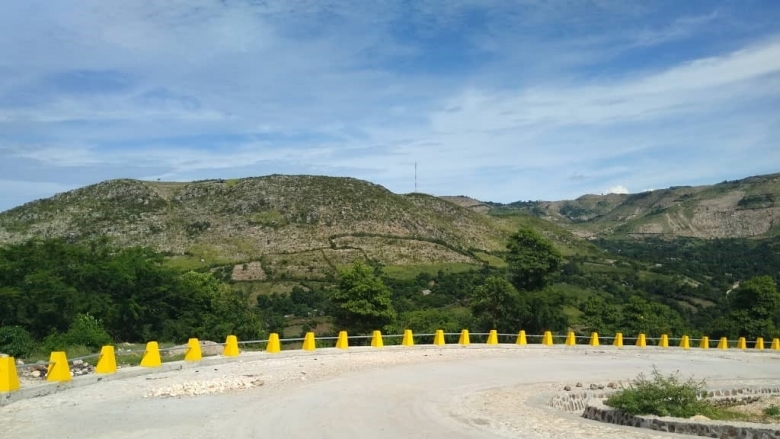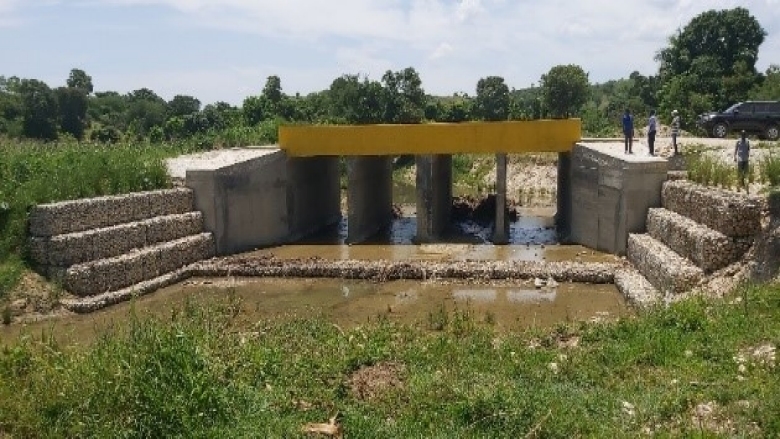Results
From May 2014 to August 2020, IDA supported the development of the Center and Artibonite Loop (CAL) region by financing the rehabilitation of 86 kilometers of rural and nonrural roads and the development of a regional road maintenance strategy, which was adopted by the government in 2017, and the provision of training to 284 people in basic rural road maintenance. The road works were carried out on road sections Hinche to Maissade, Saint Michel to Saint Raphael, Titanyen to Saut d'Eau, Dessalines to Saint Michel, and across the rural road network of Petite Rivière Bayonnais and Bas de Sault. Together, these outputs contributed to achieving key outcomes, despite a challenging context, including:
- Enhanced all-weather connectivity to the CAL between key urban centers on the loop as well as within the loop, by increasing the share of rural population with access to an all-weather road from 39 to 44 percent.
- Improved logistics for producers, increasing the number of producers and users served by an all-weather road accessing urban and rural markets by 123,500.
- Increased resilience of the CAL region to climate change, reducing the share of roads classified as vulnerable to natural events and climate change impacts by 16 percent and by improving the sustainability of road investments.
Bank Group Contribution
The World Bank, through the International Development Association (IDA), provided a grant in the amount of US$50 million to finance this project. Additionally, a US$8 million grant from the Climate Investment Fund’s (CIF) Pilot Program for Climate Resilience was leveraged to co-finance the climate-proofing of CAL’s road infrastructure. The CIF is a US$8 billion fund that accelerates climate action by empowering transformations in clean technology, energy access, climate resilience, and sustainable forests in developing and middle-income countries.
Partners
The project was implemented by the Haiti Technical Execution Unit of the Ministry of Economy and Finance and by the Central Execution Unit of the Ministry of Public Works, Transportation, and Communication. Project implementation was supported by the Executive Secretariat of CIAT and by the Ministry of Agriculture, Natural Resources, and Rural Development. To ensure complementarities between projects in the CAL region, the project was prepared in collaboration with the agriculture, disaster risk management, and transport practices of the Bank and in coordination with key donors involved in the region, including the Inter-American Development Bank and the European Union.
Beneficiaries
Producers, investors, and organizations involved in agriculture and other sectors in the CAL region benefited from the rehabilitation and construction of markets. Additionally, inhabitants from 14 municipalities benefited from improved climate-resilient transportation infrastructure, including increased year-round access to markets, and from improved local governance including transparent and participatory decision-making mechanisms. Moreover, approximately 123,500 road network users transiting in-and-out or through the CAL region (especially between the capital and the North or the Dominican Republic), benefited from the Project-financed investments in all-weather road access, namely via improved transportation and connectivity.
A November 2020 survey of 131 people conducted in four markets affected by road improvements completed under the project found that 96 percent of respondents (including producers, transporters, merchants, and consumers) declared that the road works had positively impacted their activities. Road improvements were found to have increased the reliability and speed of the delivery of goods and supplies: 84 percent of respondents declared that supply regularity was enhanced, and 93 percent said their travel time was reduced due to road improvements. In addition, two-thirds of respondents noted that road improvements had led to enhanced product quality, and 61 percent of respondents experienced an overall increase in sales volume.
Moving Forward
The Bank-financed Rural Accessibility and Resilience Project (RARP), approved in June 2020, continues the Bank’s engagement in the CAL region and is expected to strengthen the outcomes of this project. The RARP finances the rehabilitation of 95 additional kilometers of roads that were designed, procured, or partly executed under the project to further enhance all-weather connectivity and resilience across the region. The RARP also finances the construction and rehabilitation of five regional and rural markets, thus further improving logistics for producers.
Credit: Unité Centrale d’Exécution MTPTC




